

How Great Bosses Motivate Employees. Réussir la négociation d'un pacte d'actionnaires. Think Twice Before Adopting The “Ship Or Die” Mentality. Editor’s Note: This guest post is written by Uzi Shmilovici, CEO and founder of Future Simple, the company behind Base CRM.
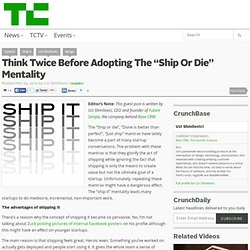
The “Ship or die”, “Done is better than perfect”, “Just ship” mantras have lately become a part of many startup conversations. The problem with these mantras is that they glorify the act of shipping while ignoring the fact that shipping is only the means to create value but not the ultimate goal of a startup. Unfortunately, repeating these mantras might have a dangerous effect. The “ship it” mentality leads many startups to do mediocre, incremental, non-important work.
The advantages of shipping it There’s a reason why the concept of shipping it became so pervasive. The main reason is that shipping feels great. The risks of just shipping it Here’s the thing though. Shipping the wrong thing — if you didn’t think through the product/feature you are shipping, you might end up shipping the wrong thing. Returns on quality Let’s talk about quality. Quality ! Things Entrepreneurs Should Avoid When Raising Capital. Editor’s note: Contributor Ashkan Karbasfrooshan is the founder and CEO of WatchMojo.
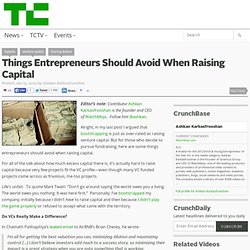
Follow him @ashkan. Alright, in my last post I argued that bootstrapping is just as over-rated as raising venture capital. But for those who decide to pursue fundraising, here are some things entrepreneurs should avoid when raising capital. For all of the talk about how much excess capital there is, it’s actually hard to raise capital because very few projects fit the VC profile—even though many VC-funded projects come across as frivolous, me-too projects. Blogs - 10 Mistakes VCs Make. Dave McClure posted a rambunctious article last week on things VCs need to change in terms of process and procedures.
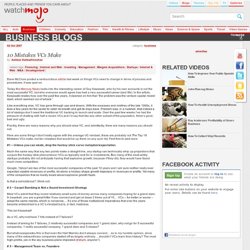
It was spot on. Today the Mercury News looks into the interesting career of Guy Kawasaki, who by his own accounts is not the most successful VC, but who everyone would agree has had a very successful career (and life). In the article, Kawasaki relates how over the past few years, it dawned on him that “ the problem was the venture capital model itself, which seemed out of whack. ” Like everything else, VC has gone through ups and downs. Why Entrepreneurs Fail And Most Startups Are DOA.
Editor’s note: Contributor Ashkan Karbasfrooshan is the founder and CEO of WatchMojo, he hosts a show on business and has published books on success.

Follow him @ashkan. No time? Not enough cash? Try these bootstrapping tips. In the summer of 2010 I caught the startup bug.
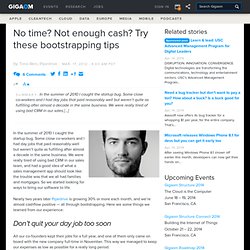
Some close co-workers and I had day jobs that paid reasonably well but weren’t quite as fulfilling after almost a decade in the same business. We were really tired of using bad CRM in our sales team, and had a good idea of what a sales management app should look like: the trouble was that we all had families and mortgages. So we started looking for ways to bring our software to life. Etsy CEO on Building a Lean Start-Up: Deploy, Deploy, Deploy - Lauren Goode - Commerce. The key to building a successful, lean start-up is to constantly tweak production and to keep your employees happy, Chad Dickerson says.
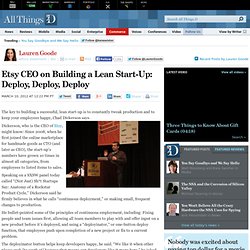
Dickerson, who is the CEO of Etsy, might know: Since 2008, when he first joined the online marketplace for handmade goods as CTO (and later as CEO), the start-up’s numbers have grown 10 times in almost all categories, from employees to listed items to sales. Speaking on a SXSW panel today called “(Not Just) Sh*t Startups Say: Anatomy of a Rockstar Product Cycle,” Dickerson said he firmly believes in what he calls “continuous deployment,” or making small, frequent changes to production. He bullet-pointed some of the principles of continuous employment, including: Fixing people and team issues first, allowing all team members to play with and offer input on a new product before it’s deployed, and using a “deployinator,” or one-button deploy function, that employees push upon completion of a new project or fix to a current problem. I’m A Startup — Why Am I Being Inundated With Cloud Providers? Editor’s note: Robert Scoble is Rackspace’s Startup Liaison and a blogger.
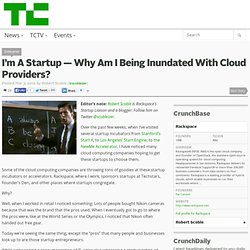
Follow him on Twitter @scobleizer. Over the past few weeks, when I’ve visited several startup incubators from Stanford’s Start X, to Los Angeles’ Start Engine, to the NewMe Accelerator, I have noticed many cloud computing companies hoping to get these startups to choose them. Some of the cloud computing companies are throwing tons of goodies at these startup incubators or accelerators. Rackspace, where I work, sponsors startups at Techstars, Founder’s Den, and other places where startups congregate. Entrepreneurs Are Difficult At Best And Abrasive at Worst — Get Over It.
Editor’s note: Contributor Ashkan Karbasfrooshan is the founder and CEO of WatchMojo, he hosts a weekly show on business and has published books on success.
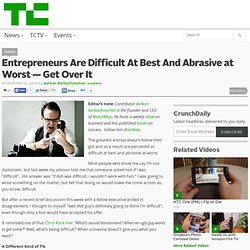
Follow him @ashkan. The greatest entrepreneurs follow their gut and as a result are perceived as difficult at best and abrasive at worst. Most people who know me say I’m too diplomatic, but last week my advisor told me that someone asked him if I was “difficult”. His answer was “if Ash was difficult, I wouldn’t work with him.” I was going to write something on the matter, but felt that doing so would make me come across as, you know, difficult. Importer une idée américaine : attention au me-too pur et simple. "On ne peut pas se contenter de copier notre équivalent américain.

Go Ask Grandma: How To Design For “Normals” Editor’s Note: This guest post is written by Nir Eyal (@nireyal) and Katy Fike, PhD (@innovate50).

Katy is a gerontologist and partner at Innovate50 while Nir is a founder of two startups and blogs about technology and behavior design at nirandfar.com. As web watchers, entrepreneurs, and investors search for the next big thing, they’d be wise to focus on innovations that can be easily adopted by technology novices. A recent string of companies, including Groupon and Pinterest, have found success outside the early-adopter digerati by building products simple enough to be used by just about anyone. Designing with tech novices in mind can mean the difference between staying niche and going mainstream. Here are three principles for designing software for people Silicon Valley too often disparagingly calls “normals.”